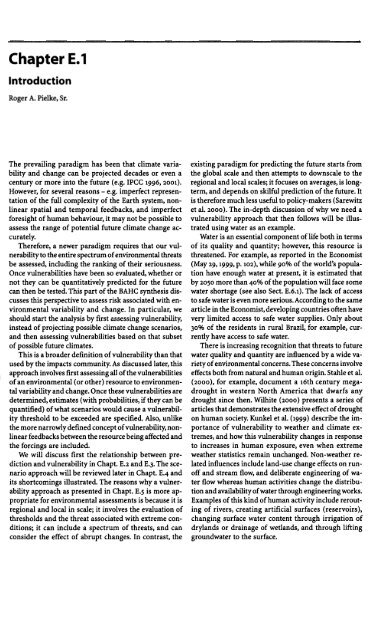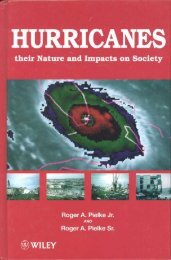How to evaluate vulnerability in changing environmental conditions
How to evaluate vulnerability in changing environmental conditions
How to evaluate vulnerability in changing environmental conditions
You also want an ePaper? Increase the reach of your titles
YUMPU automatically turns print PDFs into web optimized ePapers that Google loves.
Introduction<br />
Roger A. Pielke, Sr.<br />
The prevail<strong>in</strong>g paradigm has been that climate varia- exist<strong>in</strong>g paradigm for predict<strong>in</strong>g the future starts from<br />
bility and change can be projected decades or even a the global scale and then attempts <strong>to</strong> downscale <strong>to</strong> the<br />
century or more <strong>in</strong><strong>to</strong> the future (e.g. IPCC 1996, 2001). regional and local scales; it focuses on averages, is long-<br />
<strong>How</strong>ever, for several reasons -e.g. imperfect representerm, and depends on skilful prediction of the future. It<br />
tation of the full complexity of the Earth system, non- is therefore much less useful <strong>to</strong> policy-makers (Sarewitz<br />
l<strong>in</strong>ear spatial and temporal feedbacks, and imperfect et al. 2000). The <strong>in</strong>-depth discussion of why we need a<br />
foresight of human behaviour, it may not be possible <strong>to</strong> <strong>vulnerability</strong> approach that then follows will be illus-<br />
assess the range of potential future climate change actrated us<strong>in</strong>g water as an example.<br />
curately.<br />
Water is an essential component of life both <strong>in</strong> terms<br />
Therefore, a newer paradigm requires that our vul- of its quality and quantity; however, this resource is<br />
nerability <strong>to</strong> the entire spectrum of <strong>environmental</strong> threats threatened. For example, as reported <strong>in</strong> the Economist<br />
be assessed, <strong>in</strong>clud<strong>in</strong>g the rank<strong>in</strong>g of their seriousness. (May 29, 1999, p. 102), while 90% of the world's popula-<br />
Once vulnerabilities have been so <strong>evaluate</strong>d, whether or tion have enough water at present, it is estimated that<br />
not they can be quantitatively predicted for the future by 2050 more than 40% of the population will face some<br />
can then be tested. This part of the BAHC synthesis dis- water shortage (see also Sect. E.6.1). The lack of access<br />
cusses this perspective <strong>to</strong> assess risk associated with en- <strong>to</strong> safe water is even more serious. Accord<strong>in</strong>g <strong>to</strong> the same<br />
vironmental variability and change. In particular, we article <strong>in</strong> the Economist, develop<strong>in</strong>g countries often have<br />
should start the analysis by first assess<strong>in</strong>g <strong>vulnerability</strong>, very limited access <strong>to</strong> safe water supplies. Only about<br />
<strong>in</strong>stead of project<strong>in</strong>g possible climate change scenarios, 30% of the residents <strong>in</strong> rural Brazil, for example, cur-<br />
and then assess<strong>in</strong>g vulnerabilities based on that subset rently have access <strong>to</strong> safe water.<br />
of possible future climates.<br />
There is <strong>in</strong>creas<strong>in</strong>g recognition that threats <strong>to</strong> future<br />
This is a broader def<strong>in</strong>ition of <strong>vulnerability</strong> than that water quality and quantity are <strong>in</strong>fluenced by a wide va-<br />
used by the impacts community. As discussed later, this riety of <strong>environmental</strong> concerns. These concerns <strong>in</strong>volve<br />
approach <strong>in</strong>volves first assess<strong>in</strong>g all of the vulnerabilities effects both from natural and human orig<strong>in</strong>. Stahle et al.<br />
of an <strong>environmental</strong> (or other) resource <strong>to</strong> environmen- (2000), for example, document a 16th century megatal<br />
variability and change. Once these vulnerabilities are drought <strong>in</strong> western North America that dwarfs any<br />
determ<strong>in</strong>ed, estimates (with probabilities, if they can be drought s<strong>in</strong>ce then. Wilhite (2000) presents a series of<br />
quantified) of what scenarios would cause a vulnerabil- articles that demonstrates the extensive effect of drought<br />
ity threshold <strong>to</strong> be exceeded are specified. Also, unlike on human society. Kunkel et al. (1999) describe the im-<br />
the more narrowly def<strong>in</strong>ed concept of vUlnerability, nonportance of <strong>vulnerability</strong> <strong>to</strong> weather and climate exl<strong>in</strong>ear<br />
feedbacks between the resource be<strong>in</strong>g affected and tremes, and how this <strong>vulnerability</strong> changes <strong>in</strong> response<br />
the forc<strong>in</strong>gs are <strong>in</strong>cluded.<br />
<strong>to</strong> <strong>in</strong>creases <strong>in</strong> human exposure, even when extreme<br />
We will discuss first the relationship between pre- weather statistics rema<strong>in</strong> unchanged. Non-weather rediction<br />
and <strong>vulnerability</strong> <strong>in</strong> Chapt. E.2 and E.3. The scelated <strong>in</strong>fluences <strong>in</strong>clude land-use change effects on runnario<br />
approach will be reviewed later <strong>in</strong> Chapt. E.4 and off and stream flow, and deliberate eng<strong>in</strong>eer<strong>in</strong>g of wa-<br />
its shortcom<strong>in</strong>gs illustrated. The reasons why a vulnerter flow whereas human activities change the distribuability<br />
approach as presented <strong>in</strong> Chapt. E.5 is more aption and availability of water through eng<strong>in</strong>eer<strong>in</strong>g works.<br />
propriate for <strong>environmental</strong> assessments is because it is Examples of this k<strong>in</strong>d of human activity <strong>in</strong>clude rerout-<br />
regional and local <strong>in</strong> scale; it <strong>in</strong>volves the evaluation of <strong>in</strong>g of rivers, creat<strong>in</strong>g artificial surfaces (reservoirs),<br />
thresholds and the threat associated with extreme con- chang<strong>in</strong>g surface water content through irrigation of<br />
ditions; it can <strong>in</strong>clude a spectrum of threats, and can drylands or dra<strong>in</strong>age of wetlands, and through lift<strong>in</strong>g<br />
consider the effect of abrupt changes. In contrast, the groundwater <strong>to</strong> the surface.














